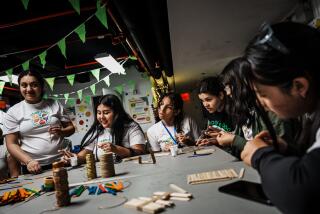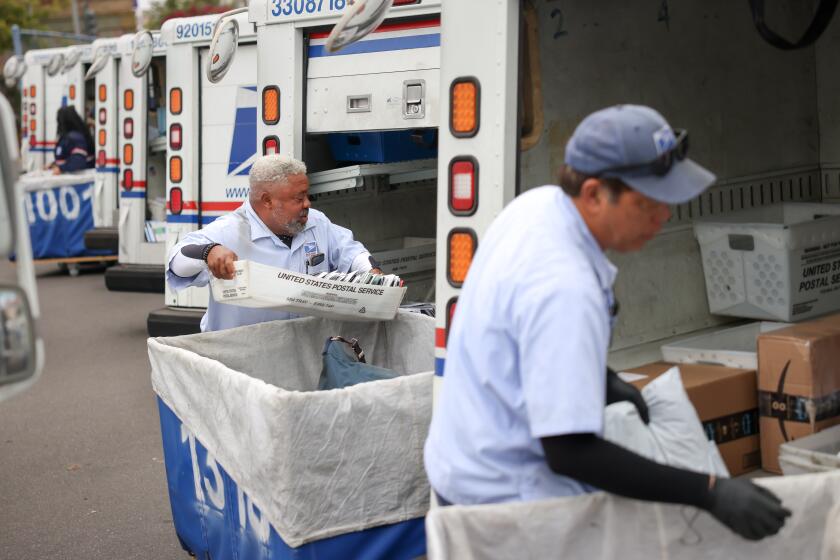Girl Scout Pledge Rings Out in Spanish as Organization Reaches for New Members
- Share via
HOLLISTER, Calif. — As the afternoon starts sweltering, girls straggle into a modest park with a lone pavilion and four trees that double as bases for kickball.
The youngest, quietest girls wear used Brownie shirts and jumpers, their long black hair meticulously combed and ribboned.
The older girls, giggling and shoving each other, wear jeans and borrowed T-shirts stamped with the Girl Scout logo.
They recite the Girl Scout promise: “Yo me esforzare a ser honrada y justa, cordial y servicial, considerada y compasiva. . . .”
The Girl Scouts, which have been promoting wholesome American girlhood since the early 1900s, are searching for new members across borders and beyond traditional neighborhoods.
“The whole purpose . . . is to provide the benefits of Girl Scouts to an audience that would not normally have access to them,” Girl Scouts of the U.S.A. spokeswoman Lori Arguelles said.
At the Southside Labor Camp, 91 miles southeast of San Francisco, migrant workers spend their days picking garlic and peppers in the fields. Their daughters spent two hours each week at Southside’s park doing civic projects for badges.
That’s until November, when Southside closes and families scatter to harvest or plant crops from Arizona to Florida.
In some of those states, the girls can pick up where they left off at other chapters. That’s part of the Border Initiative, one of many Girl Scout efforts to reach girls who look less like TV’s Marcia Brady and more like the kids down the block.
Southside has had a troop for several years. But the Border Initiative makes a special effort to target Hispanic-American migrant Latinas and to keep them in Girl Scouts even when they move.
About 10,000 girls have participated in the program in its three years. Officials acknowledge that some of the girls may be in the United States illegally, but Scout leaders don’t ask about their legal status.
In some states, the program extends to activities with the parents.
In Yuma, Ariz., program manager Sylvia Martinez-Flores said Girl Scouts have teamed up with Chicanos Por La Causa, which teaches the girls’ parents to read while they work on Girl Scout projects.
Soccer-playing preteen fans of singer Britney Spears from Midwestern exurbia still flock to Girl Scout ranks. But the organization now looks for cookie sellers in homeless shelters, among jail inmates’ daughters and around crop-laden fields.
“Just looking at demographic and immigration patterns, increasing numbers of girls are coming from new immigrant communities,” said Marsha Johnson-Evans, Girl Scouts national executive director in New York. “And if you look at border states like Texas, Arizona, New Mexico and California, increasing numbers of girls in those communities don’t have a history of Girl Scout membership.”
That membership has grown from 2.41 million girls nationwide in 1989 to 2.67 million in 1998. Hispanic membership has risen from 3.9% then to 5.7% now, and officials credit that largely to efforts like the Border Initiative.
But the outreach brings unexpected challenges.
Unlike the Boy Scouts, the Girl Scouts does not exist in Mexico by that name.
Its closest counterpart is the Girl Guides. Officials say the Girl Guides have 1,689 members across Mexico. Many rural Mexican parents have never heard of it or the Girl Scouts, and it’s harder to get them involved.
“[Recently] I tried to have a parent meeting,” said Linda Valenzuela, membership director for the Imperial Valley Girl Scouts near San Diego. “I was disappointed that not one parent showed up, even though I had walked door to door trying to get them involved.”
Valenzuela said she understands parents have their hands full simply making a living.
“I’m Mexican, and I know that for years when I was a kid we played by ourselves,” she said. “Our parents’ obligation was to put a roof over our heads and give us clothes and food. It was not up to them to entertain us.”
Some parents, confronted with a new concept of active girls who play sports and go on sleepover camp-outs, can’t relate. It doesn’t square with their traditional image of docile, protected, stay-at-home girlhood.
“My mother didn’t want to put me in Girl Scouts because she didn’t know what it was about,” said Mayra Diosdado, 12, who alternates between Southside and Mexico.
For that reason, troop leaders sometimes dilute the Girl Scout message for parents. They tell them membership builds self-esteem, while they encourage girls to break established molds and follow role models like WNBA star Rebecca Lobo--herself a Girl Scout.
Camp-outs pose special problems.
“Mothers are very protective of letting the girls go to a strange place,” said Gail Jacobs of the Girl Scouts in Phoenix. “I mean, who are these people taking my daughter away for the weekend?”
So they ask reluctant moms to come along as chaperons.
It’s changing their thinking. Some parents say they wish they had had the chance to be Girl Scouts when they were children.
“I see my daughter, and I think it would have been neat,” said Maria Franco, at 42 a longtime Southside resident. “But when you come from a working family, it’s really hard. For us it was always work, work, work in the summer.”
Boys also want what the Girl Scouts get at Southside. The place has no activities for them. Out of boredom, they make a nuisance of themselves. Troop leader Kristen Collins is talking to the Boy Scouts about setting up shop. But it hasn’t happened yet.
Meanwhile, the girls consider the meetings playtime.
“It’s real cool,” said Melissa de la Cruz, 11. “They teach you stuff you don’t know, like macrame. We made anklets and key chains.”
In heavily accented Spanish, Collins today tries to get them to do a sit-down activity. But they squeal and laugh, poking their hands up to take a vote or attendance. Instead, they count off teams and go play kickball.
They don’t think much about how they differ from the white suburban Girl Scout stereotype. But it’s obvious they sometimes envision different lives.
Melissa splits her time between California and Arizona. She says that moving constantly gets old.
“It’s not so good,” she said. “When you get used to one part you have to move away. And when you’re in the new place you miss your old friends.”
More to Read
Sign up for Essential California
The most important California stories and recommendations in your inbox every morning.
You may occasionally receive promotional content from the Los Angeles Times.










